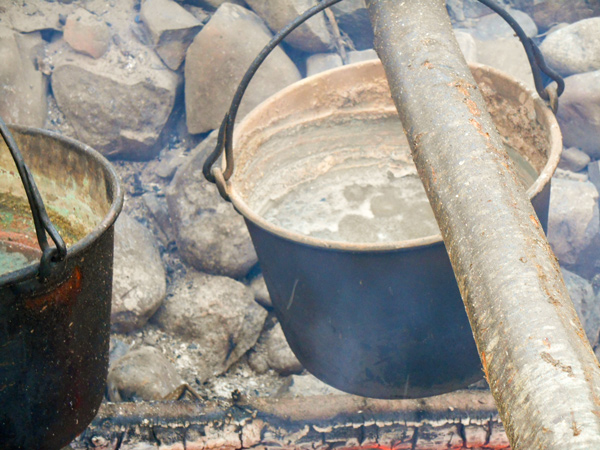At Fort Clatsop near the Pacific Ocean, the captains receive several updates: a report from the salt makers, the location of two previously missing hunters, and new information about the Tillamooks. Lewis begins his dissertation on local fruits and berries.
Hunters and Salt Makers, Berries and Bands
by Yellowstone Public Radio[1]Originally aired weekdays by Yellowstone Public Radio during the Bicentennial observance of 2003-2006. Narrated by Hal Hansen. Scripts by Whit Hansen and Ed Jacobson. Produced by Leni Holliman. © … Continue reading
Hunters
Colter returned and repoted that his comrade hunter Willard had continued his hunt from point Adams towards the salt makers; and that they had killed only those two deer which the Indians brought yesterday.
—Meriwether Lewis
Salt Makers’ Progress
In the evening Collins one of the saltmakers returned and reported that they had mad about one bushel of salt & that himself and two others had hunted from the salt camp for five days without killing any thing and they had been obliged to subsist on some whale which they procured from the natives.
—Meriwether Lewis
Tillamook Indians
I have lately learned that the natives whome I have heretofore named as distinct nations, living on the sea coast S. E. of the Killamucks [Tillamooks], are only bands of that numerous nation . . . . their language also is somewhat different from the Clatsops Chinnooks [Chinooks] and Cathlâhmâhs [Kathlamets]; but I have not yet obtaind a vocabulary which I shall do the first oportunity which offers.
—Meriwether Lewis
Native Fruits and Berries
The native fruits and buries in uce among the Indians of this neighbourhood are a deep purple burry about the size of a small cherry called by them Shal-lun, [salal] a small pale red bury called Sol’-me; [false Solomon’s-seal] the vineing or low Crambury, [wild cranberry] a light brown bury reather larger and much the shape of the black haw; [Oregon crabapple] and a scarlet bury about the size of a small cherry the plant called by the Canadin Engages [engagés] of the N. W. sac a commis produces this bury; [bearberry] this plant is so called from the circumstance of the Clerks of those rading companies carrying the leaves of this plant in a small bag for the purpose of smokeing of which they are excessively fond.
—Meriwether Lewis
Weather Diary
aspect of the weather at rise
Wind at rise
Weather at 4 OC. P.M. Wind at 4 OC. P.M. hail after rain, hail, & snow N. E. cloudy after rain, hail & snow N E the ground covered with snow this morning ½ inch deep ice on the water in the canoes ¼ of an inch thick. it is now preceptably coulder than it has been this winter.—
—Meriwether Lewis[2]To assist the reader, the editor of this web page has omitted the “Day of the month” column and spelled out some abbreviations.
Experience the Lewis and Clark Trail
The Lewis and Clark Trail Experience—our sister site at lewisandclark.travel—connects the world to people and places on the Lewis and Clark Trail.
Plan a trip related to January 25, 1806:

Fort Clatsop is a High Potential Historic Site along the Lewis and Clark National Historic Trail managed by the U.S. National Park Service. The site is managed by the Lewis and Clark National and State Historic Parks.
Notes
| ↑1 | Originally aired weekdays by Yellowstone Public Radio during the Bicentennial observance of 2003-2006. Narrated by Hal Hansen. Scripts by Whit Hansen and Ed Jacobson. Produced by Leni Holliman. © 2003 by Yellowstone Public Radio. |
|---|---|
| ↑2 | To assist the reader, the editor of this web page has omitted the “Day of the month” column and spelled out some abbreviations. |



